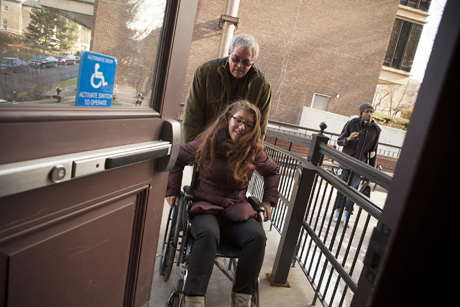Simulations show ins and outs of campus access
By Daniel Aloi


Cornell administrators, employees, alumni and student leaders learned firsthand about accessibility and inclusion on campus for people with disabilities during a series of simulations Nov. 25.
The student-led Cornell Union for Disabilities Awareness (CUDA) invited campus leaders to use crutches, a wheelchair or a motorized scooter in the simulations, while pointing out positive and negative aspects of access at Day Hall, Rockefeller Hall, Willard Straight Hall, Martha Van Rensselaer Hall and the Cornell Store.
Six CUDA members led the participants on tours designed to show access to building entrances, restrooms, elevators, dining facilities, offices and classrooms.
“The purpose of the activity is to inspire thought, and how we as leaders can affect change on this campus,” CUDA President Lawrence Goun ’15 said.
President David Skorton, Vice President for Student and Academic Services Susan Murphy ’73, Ph.D. ’94, and Police Chief Kathy Zoner took the Day Hall tour, led by David Tauber ’16.
Barriers to access during the simulations included stairs at entryways, tight corners in hallways and restrooms, and elevators located in areas used to store equipment. CUDA members also pointed out a lack of proper signage in some buildings indicating the location of classrooms, offices and other important rooms.
Dean of Students Kent Hubbell ’67, B.Arch. ’69; Risley Hall Resident Adviser Juliana Batista ’16; and Student Assembly President Ulysses Smith ’13 toured Rockefeller Hall, along with Andrea Haenlin-Mott, the Americans with Disabilities Act coordinator for Cornell Facilities Services. Haenlin-Mott, Associate Dean of Students Travis Apgar and Assistant Dean of Students Kara Miller toured the Straight, Cornell’s student union. Participants at the other sites included student trustee Ross Gitlin ’15, professor and ergonomics researcher David Feathers and biomedical engineering lecturer Susanne Solomon.
At each site, CUDA students highlighted the presence or absence of user-friendly facilities that community members and visitors with and without disabilities might encounter.
“We want to show what’s there, what improvements have been made, and what opportunities exist to make improvements to access,” Goun said.
For example, a temporary wheelchair ramp was installed at the Straight’s front entrance last summer, and a permanent ramp is being constructed, Apgar said. However, the only access to third-floor dining rooms for persons with physical disabilities is via a freight elevator in a storage area off the Memorial Room.
Tauber pointed out “a beautifully accessible restroom” in Day Hall, while Goun noted some confusing signage and a potentially problematic classroom layout in Rockefeller Hall.
“It’s a huge challenge, and this really does help illustrate very clearly what we need to do,” Hubbell said.
“Multiply this by every building on campus,” said Haenlin-Mott, who uses a wheelchair. “A broadening of access for everybody is what we’re looking for. For a lot of people, accessibility may not be all that clear. It’s something we all need to identify and communicate for everyone.”
Access and inclusion: What you can do
The Cornell Union for Disability Awareness (CUDA) encourages community members to become part of the solution for accessibility and inclusivity on campus. Some actions CUDA recommends:
• Make sure your organizations meet in user-friendly locations.
• Arrange your workspace and living space to be as accessible as possible.
• Think about obstacles in your lab, office, studios, etc. and how you might remove them.
• Be committed to and vocal about accommodating the needs of others.
• Resist helping people with disabilities when they are not asking for assistance.
• Tell your fellow students, alumni, faculty, staff and administrators about where you feel that accessibility and inclusivity could improve and why it is important to you and to others.
She said that in the spring, she and Kappy Fahey, director of Student Disability Services, would be reviewing all requests for events held on Cornell property for how event organizers plan to address accessibility.
“We are taking a very aggressive approach to identifying and fixing our barriers on campus, and both large-scale and small-scale accessibility issues,” Haenlin-Mott said. “On a building-by-building basis, we go in and try to address as many deficiencies as we can.”
Social accessibility and inclusion are as important as physical access, Fahey said, adding that acts of courtesy – “opening doors for people, making way for them; and if you’re driving, stopping so people can cross the street, all … help make this a caring community.”
Campus Information and Visitor Relations Director Taiya Luce said her staff is trained to accommodate persons with disabilities. Fahey said that similar training for others would benefit the wider campus community.
“Disability should be embraced as a part of diversity,” said CUDA Adviser Erin Sember-Chase, technical assistance coordinator for the Employee and Disability Institute.
Tauber’s interest in CUDA began with an introductory course in disability studies Sember-Chase co-teaches. “Disability struck me as a topic that anyone can relate to,” he said. “It can affect them personally, or their family members, at any time.”
“This is an ongoing project,” Goun said. “Everybody can contribute in some way. Students can make their workspaces more accessible and their event locations accessible. Alumni can help make access an issue, and professors and staff [as well], because this is where they work.”
For more information, email cuda@cornell.edu or visit the Accessibility on Campus website.
Media Contact
Get Cornell news delivered right to your inbox.
Subscribe